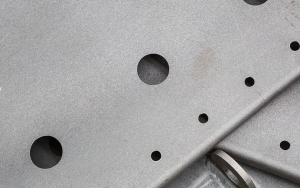Melt index is a number that indicates the fluidity of plastic materials during processing. It is the American Measurement Standards Institute (ASTM), according to the United States DuPont company customary identification of plastic properties developed, it is the American Measurement Standards Institute (ASTM).
The test method of melting index:
First, let the plastic particles melt into plastic fluid, and then at a particular time (10 min), a specific temperature and pressure (various material standards are different) through a diameter of 2.1mm round pipe after the measurement of its grams (g) number. If the melting index is higher, the better the fluidity of plastic; On the contrary, the worse the liquidity.
The measurement principle of melting index:
Its principle is to put the plastic or resin into a fixed diameter of the metal sleeve, and heat the plastic or resin melting, then give a certain load on the piston, the weight of the piston has been molten plastic extruded from a small hole, and calculate the weight of the plastic extruded. Because of the same material, this measurement method, the inner diameter of the barrel, the load, and the temperature are fixed.
In practical applications are generally not spend 10 minutes for test it, because it not only need to spend a lot of time, and also need to spend a lot of plastic material, Usually, it will take 10 – 20 seconds to estimate the materials melt index, but have to try to adjust according to actual condition, if the flow speed is too slow, we must increase the time, If it is too fast, the amount of plastic or resin test must be increased. It is recommended to record the test conditions of certain plastic materials to avoid future measurement differences. The conditions of each test should also be fixed to have a comparative reference.
In general, the higher the Melting Index value, the lower the viscosity of the plastic, and the shorter the long molecular link. In practice, the Melting Index value can be used as resin feeding inspection and plastic injection processing product quality inspection and control.
The injection molding plastic is made up of many long chains of molecules that are entangled. The longer the chains are, the more entangled they become, kind of like coil springs, where the longer the coil springs are placed together, the more entangled they become; if the plastic is doped with secondary materials, its Melting Index value is usually more than 50% higher than the plastic particles before molding (depending on the molding conditions and materials) after molding.
In addition, it should be reminded that humidity will directly impact the testing of the Melting Index value, so it must be dried and dehumidified according to the specification requirements of plastic pellets before testing.
The length of the test time may also affect the accuracy of the results. If the sampling time is too short, it is easy to cause significant errors. The longer the time, the more samples need to be tested, but the more objective the relative results.
The Melting Index of commonly injection molding materials
| Materials Type | Melt Index (°C/Kg) |
| Acetals | 190/2.16 |
| Acrylics | 230/1.2 | ABS | 220/10 |
| ABS+PC | 265/3.8 |
| Nylon 66 | 275/0.325 |
| Nylon 6 | 235/2.16 |
| Polycaprolactone | 125/2.16 |
| Polyethylenee | 125/1.2 |
| Polycarbonate | 300/1.2 |
| Polypropylene | 230/2.16 |
| HIPS | 230/3.8 |
| PET | 285/2.16 |
| PBT | 250/2.16 |
| Phenylene sulfidee | 315/5.0 |
Categories
Share On
Recent Post

Sandblasting Surface Finish Explained
Sandblasting is a powerful method used in different industries to

Injection Molding Defects: Brittle crack
Here is a painful lesson learned by one of our


